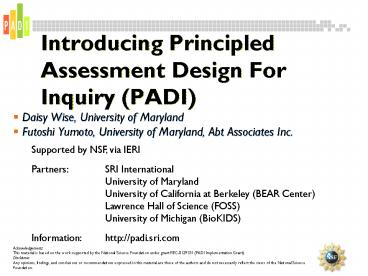Introducing Principled Assessment Design For Inquiry PADI - PowerPoint PPT Presentation
1 / 16
Title: Introducing Principled Assessment Design For Inquiry PADI
1
Introducing Principled Assessment Design For
Inquiry (PADI)
- Daisy Wise, University of Maryland
- Futoshi Yumoto, University of Maryland, Abt
Associates Inc.
Supported by NSF, via IERI Partners SRI
International University of Maryland Universit
y of California at Berkeley (BEAR
Center) Lawrence Hall of Science
(FOSS) University of Michigan (BioKIDS)
Information http//padi.sri.com
Acknowledgements This material is based on the
work supported by the National Science Foundation
under grant REC-0129331 (PADI Implementation
Grant). Disclaimer Any opinions, findings, and
conclusions or recommendations expressed in this
material are those of the authors and do not
necessarily reflect the views of the National
Science Foundation.
2
The Problem
- Creating good inquiry tasks is hard.
- How to do it validly and efficiently?
- Whats the connection with standards?
- Whats the connection with the learning
psychology? - How to implement within given content, for given
kinds ages of students? - How do you score it?
- How to sort out confounded evidence?
- How to leverage technology?
3
The PADI Solution
- Conceptual frameworks representations
- Evidence-centered design approach
- Object model for designing assessment arguments
and assessment tasks. - Allows for the collaboration of individuals with
expertise from different domains. - Uses a common language and representations
- Software tools to aid processes of
- Design
- Implementation
- Delivery
4
The PADI Solution (2)
- PADI focus is on ...
- Design framework (Design patterns, templates,
delivery system) - Assessing inquiry in science
- PADI focus is not on ...
- Tasks, per se (although there are examples,
through FOSS, BioKIDS, other exemplars) - Authoring systems
- Delivery systems (exception scoring engine
module)
5
Evidence-Centered Design
- The assessment problem To draw inferences about
student proficiencies based on limited
observations. - Evidence-Centered Design Defines elements of the
assessment argument and relationships between
them. - What do we want to know about students?
- What constitutes evidence of knowing?
- How can that evidence be elicited from students?
- What are the appropriate statistical techniques
for making valid student inferences about what
students know from what students do?
6
The PADI Solution
- Evidence-Centered Design Layers
- Mislevy, R., Riconscent, M. (2005).
Evidence-centered assessment design Layers
structures and terminology. (PADI Technical
Report 9). Menlo Park, CA SRI International. - Downing S.Mgt, Haladyna, T. M. (2006). Handbook
of test development. Mahwaj, NJ. Erlbaum.
7
The PADI Solution
PADI Design Patterns Narrative structures for
the design of an assessment of pervasive kinds of
knowledge / skill / capabilities, such as
model-based reasoning, inquiry cycles, building
scientific explanations.
- Evidence-Centered Design Layers
- From Mislevy Riconscente, PADI Technical Report
- Also in Downing Haladyna, Handbook on Test
Development
8
The PADI Solution
PADI Templates Task Specs Technical
structures for specifying elements such as what
skills are being measured, the tools used for the
assessment, and the statistical analysis
procedures, and their interaction.
- Evidence-Centered Design Layers
- From Mislevy Riconscente, PADI Technical Report
- Also in Downing Haladyna, Handbook on Test
Development
9
Main Components of PADI
10
Assessment Objects in the PADI Design System
11
GLOBE Program
- Global Learning and Observations to Benefit the
Environment (GLOBE) is a worldwide hands-on,
elementary and secondary school-based education
and science program (www.globe.gov). - Investigation assessments developed for GLOBE in
a previous NSF grant address multiple, integrated
inquiry skills within Earth Science topics
(globeassessment.sri.com).
12
Task Model Variables in GLOBE
13
Student Model in GLOBE
14
Evidence Model in GLOBE
15
PADI Tools Available
PADI Task Specifications
PADI Design System
Design
PADI Design Wizards
Instantiated Tasks
Assessment Authoring System
Implementation
PADI Calibration Engine
Design Team
Student Database
PADI Scoring Engine
Assessment Delivery System
Students
PADI Gradebook
15
16
Conclusion
- The PADI system is
- A collaborative environment for creating coherent
assessments. - Interactive and web-based
- Flexible to allow for many different assessment
types - A way for increasing conceptual understanding of
the construct being measured.































